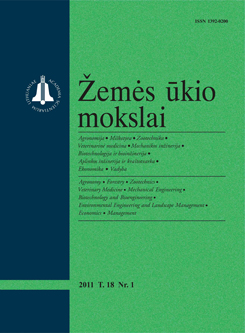Žemės ūkio mokslai / Agricultural Sciences
WHAT?
 ISSN 1392-0200 |
2007 m. Nr. Priedas Targeting development policies for lagging rural areas:
Latvia case study
The background for this paper is the 2005 assessment of Latvian rural support policies (Saktina and Meyers), which found that the RDP implementation has increased rather than reduced the polarization between richer central and western regions and poorer eastern rural areas, and as a whole, the sustainability of rural development in Latvia has remained low. The study produced key policy recommendations, including that RDP funds should be better targeted to farms, rural entrepreneurs and territories in the disadvantaged regions.
In order to implement any such targeting of measures, capacity building or funding on a territorial basis, much more needs to be known about appropriate indicators and typology of rural areas. We applied factor analysis and cluster analysis, using numerous demographic, socio-economic and land resource indicators to identify lagging territories at the NUTS 5 level. A group of 144 local municipalities were identified as comparatively less economically and socially developed and also geographically remote. Most of these were in one region, Latgale (NUTS 3), which also implies different actions than may obtain when lagging territories are more widely scattered around a country. Some means to target the lagging areas are suggested, including more targeted attention in terms of capacity building and rural development funding, especially for measures that are most appropriate for business development, job creation, and increasing productivity of agricultural and forestry activities. Keywords: lagging territories, place-based approach, rural development, targeted funding envelopes, typologies |
Numeriai:
2012 - T.19 Nr.1 2011 - T.18 Nr.1, Nr.2, Nr.3, Nr.4 2010 - T.17 Nr.1-2, Nr.3-4 2009 - T.16 Nr.1-2, Nr.3-4 2008 - T.15 Nr.1, Nr.2, Nr.3, Nr.4 2007 - T.14 Nr.1, Nr.2, Nr.3, Nr.4, Nr.Priedas 2006 Nr.1, Nr.1.Priedas, Nr.2, Nr.3, Nr.4 2005 Nr.1, Nr.2, Nr.3, Nr.4 2004 Nr.1, Nr.2, Nr.3, Nr.4 2003 Nr.1, Nr.2, Nr.3, Nr.4 2002 Nr.1, Nr.2, Nr.3, Nr.4 2001 Nr.1, Nr.2, Nr.3, Nr.4 |